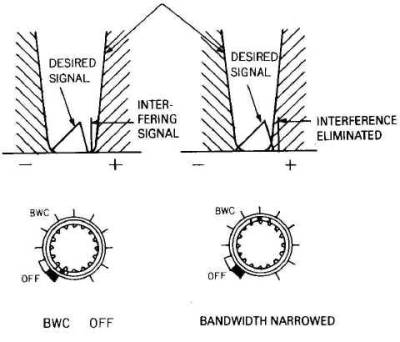Inhaltsverzeichnis
Signal processing
With simple radio sets, only the frequency and the volume can be adjusted.
High-quality „world receivers“, semi-professional and professional shortwave receivers, have various possibilities of improving a weak signal and making it intelligible.
Bandwidth control
The term selectivity refers to the ability of a receiver to receive a signal next to another signal without interference or to separate two signals in very close neighborhood on the dial.
In the shortwave range, the radio stations in the shortwave broadcast bands are located quite close to each other, usually with a channel spacing of 5 kHz. A transmitter in the next channel 5 kHz up or down to the desired frequency can strongly impair the signal, an unpleasant whistling tone will occur with a pitch of 5 kHz. On medium waves, this phenomenon is less a problem with a channel spacing of 9 kHz (internationally) or 10 kHz (in the USA), on VHF with a channel spacing of 50/100 kHz, adjacent channel interference is only a problem with extremely weak signals in the vicinity of a very strong signal „booming in“.
 In each receiver, only a very narrow section of the entire frequency spectrum is filtered out and demodulated. The task of letting only the desired signal through is performed by the bandwidth filters or IF filters.
In each receiver, only a very narrow section of the entire frequency spectrum is filtered out and demodulated. The task of letting only the desired signal through is performed by the bandwidth filters or IF filters.
In cheap receivers, only one cheap quite large filter is built in; in these „world band radios“, it happens that several stations are heard from the loudspeaker at the same time. In high-quality receivers, two or more IF filters are built in, with a NARROW / WIDE switch or a Bandwidth selector, the most favourable filter for the reception situation can be selected.
It is also important to select the optimum bandwidth considering the reception mode: IF filters with a width of 4 - 6 kHz are useful for AM reception of broadcasting stations, 1.8 - 3 kHz for SSB reception, and narrowband filters with a width of 250 - 500 Hz are used for CW reception.
LC filters are inexpensive because they consist only of a capacitor and a coil, but they can only have a high quality or steep skirts at low intermediate frequencies. Ceramic filters are also inexpensive and better suited for a higehr IF. More expensive are steep crysal filters and the best results are achieved in shortwave receivers with expensive mechanical filters.
In some receivers, a continuously variable bandwidth (BWC) has been implemented. With modern DSP technology (digital signal processing), the IF bandwidth is set digitally with programmable filter curves.
Passband Tuning
 Due to the proximity of stations on the dial in the shortwave range, often adjacent channel interference is occuring. This interference can be heard as whistling noises, which sometimes make reception inacceptable. Problems occur especially when receiving a weak signal from a station direct neighborhood below or above a very strong station.
Due to the proximity of stations on the dial in the shortwave range, often adjacent channel interference is occuring. This interference can be heard as whistling noises, which sometimes make reception inacceptable. Problems occur especially when receiving a weak signal from a station direct neighborhood below or above a very strong station.
With passband tuning, the passband curve of the IF filter is shifted relatively to the signal. In the case of an interfering signal that is, for example, 3 kHz above a desired signal, the passband curve can be shifted downwards and the interfering signal is faded out.
In this way, especially when the so-called ECSS reception is used, a barely intelligible station can be made audible. In single sideband mode, the receiver is set to the sideband with less interference (i.e. to LSB (lower side band) if there is a strong interfering signal on the frequency above the reception frequency. With certain receivers, this even works fully automatically with the SYNC function; the signal does not have to be tuned to „zero beat“ first by manually shifting the auxiliary carrier generated in the set until the whistling disappears.
Notch Filter
Some interference, which can be heard as whistling noise, is caused by an interfering signal within a sideband of an AM or SSB station. In this case, it is not possible to deal with it by cutting the bandwidth with the narrow IF filter or by receiving only the undisturbed sideband.
In this case, a notch filter can be used to „punch out“ a small area of the signal, thus eliminating the whistling. In some units, the notch filter operates at the radio-frequency (IF) level, where the IF signal is processed. An eliminated strong interfering signal can no longer have negative influence on the gain control AGC.
In other units, the notch filter works at AF level; in these the whistling tone is filtered out of the audio signal. This circuit has the advantage that the success does not depend on the nature of the whistling tone; the circuit is ultimately indifferent to the way in which the whistling has been generated. However, if the eliminated pitch is lying in the speech range, the speech may become unintelligible or the music, with some tones missing, unenjoyable.
After a station has been tuned in, the appropriate operation mode has been selected and IF bandwidth pass band tuning has been optimally adjusted, the notch filter (NOTCH) is finally switched on and the whistling tone is faded out as much as possible by turning the control carfefully.
A few sets, such as the AOR AR-7030, have a fully automatic notch filter that automatically adjusts to the pitch of the interfering signal.
